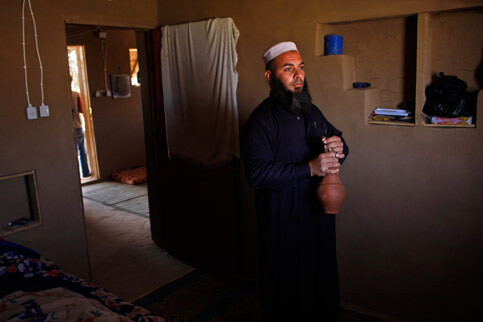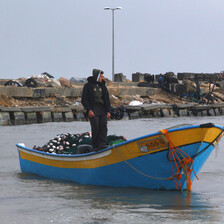The Electronic Intifada 8 May 2009

A Palestinian man is seen in his clay-built home in Rafah in the southern Gaza Strip, April 2009. (Hatem Omar/MaanImages)
RAFAH, occupied Gaza Strip (IPS) - Jihad al-Shaar is pleased with his mud-brick house in the Moraj district of Gaza. The 80-square meter home is a basic one-story, two-bedroom design, with a small kitchen, bathroom and sitting room, made mostly with mud and straw.
“My wife and our four daughters and I were living with family, but it was overcrowded, impossible. We knew we had to build a home of our own,” Shaar said. “We waited over two years for cement but because of the siege there is none available. What could we do, wait forever?”
So he decided to do it with mud.
Building earthen structures like bread ovens and small animal pens is a technique many Palestinians are familiar with, but extending the method to houses isn’t a notion that has taken hold in Gaza.
Jihad al-Shaar got the idea from his travels in Asia and the Middle East. “I traveled in Bangladesh, India, Yemen, Turkey … they all use some similar technique of building houses from earth. All you need is clay, sand and some straw.” These he mixed with water, and poured into brick moulds that were left in the sun to dry for three days. Good enough to build a fine house with.
While some Gaza residents speak of shame at the way life has “gone backwards” with the siege — using cooking oil in cars, wood fires for cooking, and horse and donkey carts for transportation — Shaar is proud of his clay home.
“In the winter it is warm, and in the summer it will be cool. There’s no problem with leaking, and this type of house will last a lifetime,” he says. “And it was cheap to build. A house this size made of cement would cost around $16,000 at least. This one, because it was made with simple, local materials cost just $3,000.”
Prior to Israel’s crippling siege on Gaza cement would have cost 20 shekels (about $5) a bag. Now, with cement among the many banned items, what does make it into Gaza through tunnels under the Egypt border costs ten times as much.
The $3,000 Shaar spent was mostly on support metal and on the flakes of straw used in the mud bricks as a strengthening agent. The metal bits, formerly just over 1,000 shekels a ton, are now quadrupled in price, which contribute to making an otherwise cheap building process still somewhat pricey.
Straw abounds, but due to the siege it is more often used as animal fodder, rendering it more precious and driving the price up. Clay and sand, found all over Gaza, must still be transported to the building site.
Compared to a cement home, the mud homes Shaar has designed and taught others to build are nonetheless the most practical and immediate solution.
Nidal Eid, 35, has seven children and has been renting a home in the Rafah region since his house was bulldozed by the Israeli army four years ago. Larger than Shaar’s and still in its nascent form, Eid’s home will take another two weeks to complete, he estimates, and will cost roughly $4,000.
“It’s going to be fantastic,” Eid said, adding mud mortar and new bricks to the waist-high wall he has already completed. “We make about 1,000 bricks every three days.”
The work, he said, was shared between six people. “I couldn’t wait any longer for the siege to end. I have a family and we need a house, so I’m building this. Everything is difficult in Gaza, but we have to find ways to get by.”
A tour through Jihad al-Shaar’s home shows all sorts of creative touches to the simple structure. Inlaid shelves are custom-sized to hold gas lanterns, dishes, ornamental vases, books, an earth-brick bed eliminates the need for an additional bed frame. The 35cm thick walls keep the house surprisingly cool, and the wooden windows propped open by poles allow the breeze to pass through.
This sort of idea is catching on. Yousef al-Mansi, minister for public works and housing says the ministry will build a school, a mosque, and a clinic out of recycled rubble from bombed buildings.
The Gaza crossings online database of the United Nations Office for the Coordination of Humanitarian Affairs (OCHA) records that only two trucks carrying construction material have been allowed into Gaza since 19 January this year. Israel’s assault on Gaza ended 18 January.
While $4.5 billion in aid money for reconstruction has been pledged by international donors, to date Israel has not permitted the entry of materials into Gaza.
During its three-week assault Israel destroyed some 5,000 homes and 20,000 buildings.
“Since I’ve made my house, I’ve got many calls from people, especially in Rafah, who want to rebuild their houses using this technique,” says Shaar. “There are entire families living in tents. Why not build a home like this? Because of the siege, we’ve found other ways of living.”
All rights reserved, IPS - Inter Press Service (2009). Total or partial publication, retransmission or sale forbidden.





